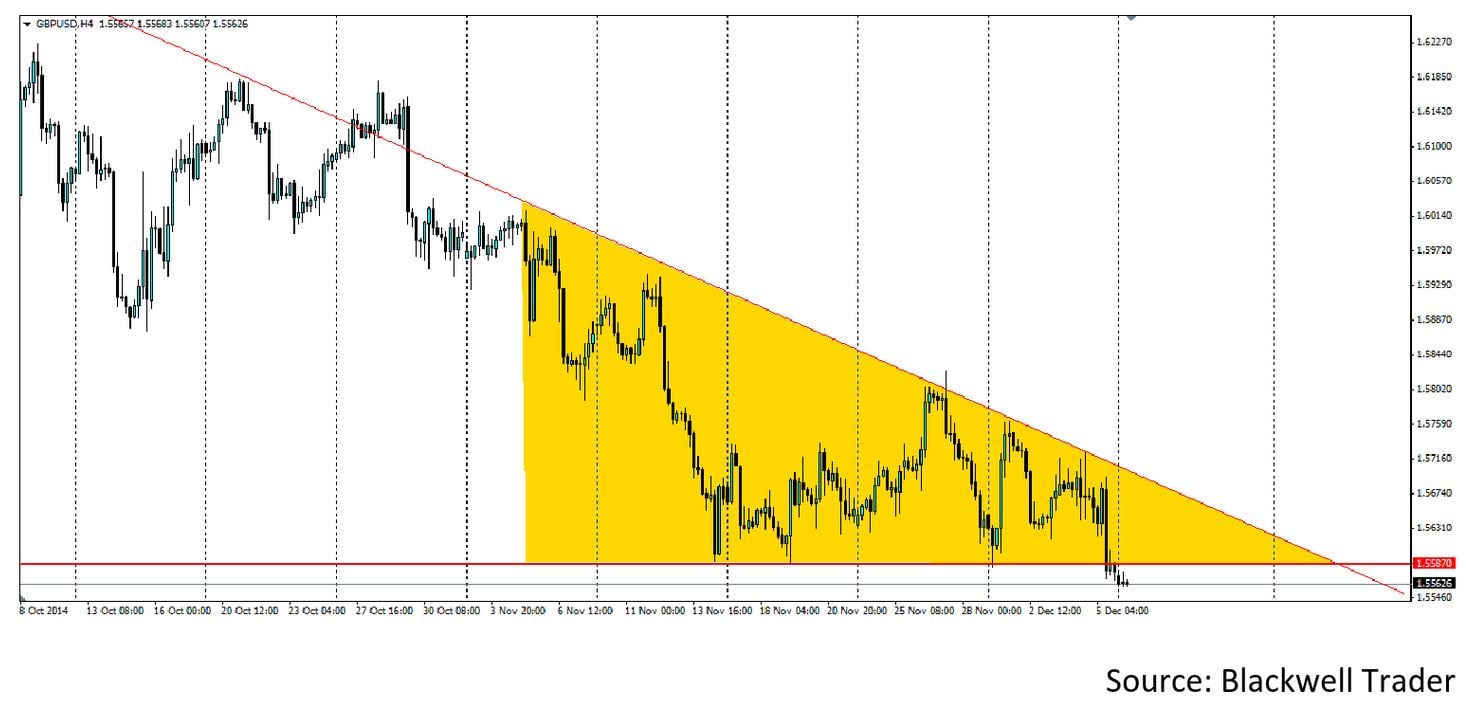GBP/USD Forecast at 1.45 in 2015 by Leading Investment Bank
- Written by: Will Peters
-

Morgan Stanley have told clients they are predicting a continuation of the downtrend pattern currently dominating movement in the GBP/USD.
The call comes as we witness the currency pairing desperately trying to defend the mid 1.55 level.
- On Monday the 8th of December the pound to dollar exchange rate (GBP/USD) is seen trading 0.23 pct lower than seen on Friday's close at 1.5548.
- The US dollar to pound sterling (USD/GBP) exchange rate is at 0.6432.
Be Aware: The above quotes are taken from the wholesale market and your bank will affix a spread at their discretion. However, an independent FX provider will guarantee to undercut your bank’s offer, thereby delivering up to 5% more currency in some instances.
To gaurd against currency fluctuations we recommend discussing a trading strategy whereby a gauranteed stop-loss level, optimal buy level and locked-in forward contract are considered. Find out more.
Morgan Stanley: Outlook Favours the Dollar in 2015
Hearing another investment bank tell us they are forecasting dollar strength in 2015 is hardly surprising. What is of interest to us however is the conviction of each call.
Commenting on their negative GBP/USD call, Morgan Stanley tell clients:
"We now expect GBP to lose relative strength in the coming year, and we have lowered our forecasts, especially for GBP/USD. We see potential for a decline to 1.45 during 2015.
"GBP is set to face a fresh set of challenges in the coming year, including a moderation in the growth outlook, increased political uncertainty surrounding the general election and the prospect of another round of fiscal consolidation. Politics and the fiscal position will be significant risk factors for GBP in 2015.
"Being bearish GBP/USD is one of our top trading ideas for 2015 – targeting the 1.45 area."
The Short-Term Outlook
Is a pullback due in the sterling dollar rate?
The below analysis from Ross Woodfield at Blackwell Global shows why there will be no shortage of contrarians looking to but the pound sterling in anticipation of a relief-styled rally:
"The Pound has had another tough week that has resulted in a breakout of the main support level of the descending triangle. A pullback close to this level will be a good trigger for an entry as a breakout-pullback play.
"Last week also saw a breakout of the consolidation pattern. The descending triangle is a bearish signal and that certainly played out nicely with the bearish trend line holding firm. The support at 1.5587 came under immense selling pressure and the price broke out. This is now set up for a classic breakout-pullback play.
"Look for an entry on a short position on the pullback close to the previous support level at 1.5587 as this will now act as resistance. A stop loss should be set not far over this to mitigate against a break back into the shape.
"Any of the support levels will act to hold up the price as it moves down. These can be found at 1.5529, 1.5485 and 1.5425.
"The Pound has broken out of the descending triangle against the US Dollar. If we see a pull back to the previous support level, this could be a trigger for a short position to catch a larger movement lower."
USD to Remain Firm on Strong Payrolls
Headline US payrolls came in much firmer than expected on the first Friday of December - up 321k in for the previous month, there were also upward revisions to the October and September numbers.
"This prompted USD gains across the board as short dated US yields rose to the highest level since 2011 on US rate hike expectations being brought forward. Furthermore, the strong report will likely support market expectations that the ‘considerable time’ language will be dropped from the December 17 FOMC statement," note Lloyds Bank Research.
It’s a relatively light data calendar from the US this week with only retail sales on Thursday, however we suspect the USD will remain supported on the back of the strong payrolls report.
Elsewhere, ECB’s second tranche of the TLTRO programme looks set to be the key focus of the week.
Draghi last week pushed back the prospect of further monetary stimulus to Q1 next year arguing that more time was needed to assess the impact current stimulus measures and of recent oil price developments on inflation expectations. Whether more measures will be announced or the likely timing remains unclear.
However, another low take up at this TLTRO operation will likely increase market speculation of action at the next ECB meeting (Jan 22).

